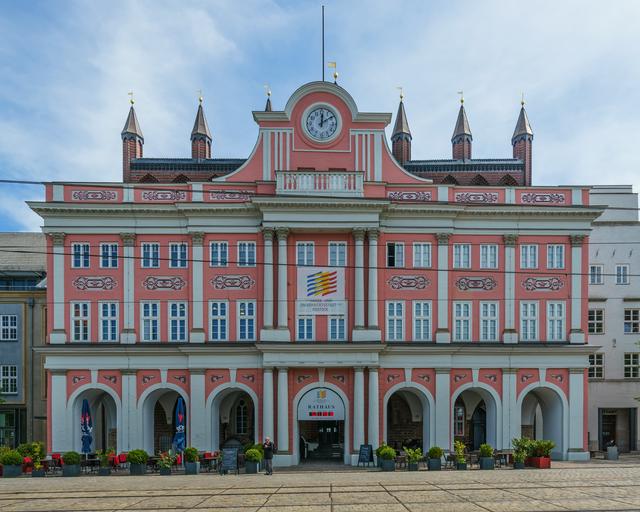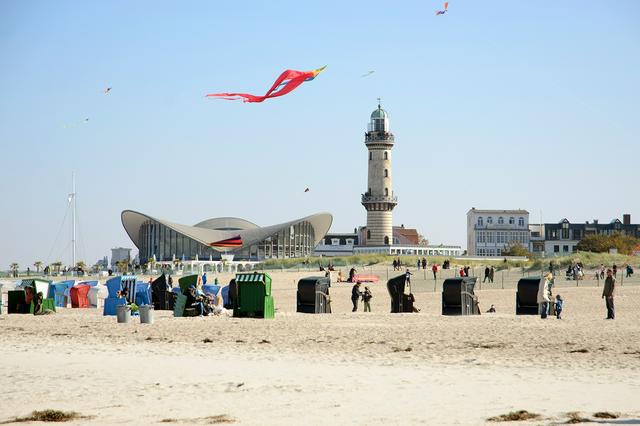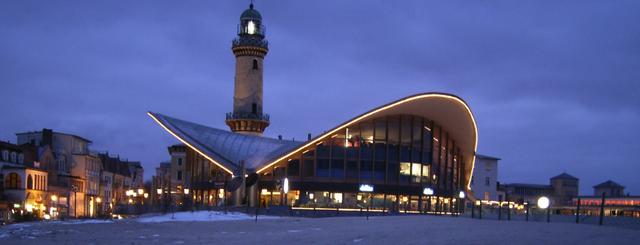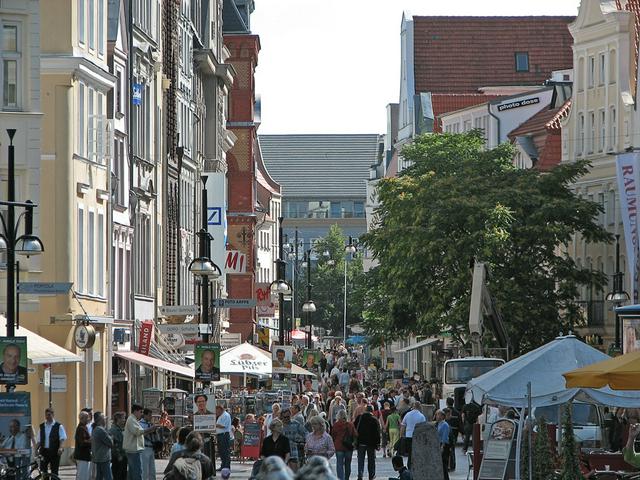Rostock is the largest city in the German state of Mecklenburg-Western Pomerania, though not its capital. It is a hub for Baltic Sea ferries, Germany's largest port for cruise ships by number of boardings and pleasant enough for a longer stay mostly due to its Hanseatic heritage.


Rostock is near the Baltic Sea and to protect its fishing and access rights it annexed Warnemünde (named for being the mouth of the river Warnow), a port area to the north. Rostock was an important member of the Hanseatic League, and one of the most important ports of the GDR (East Germany). Until the collapse of the East German economy in 1989/90 Rostock was a major center for shipbuilding and a few shipyards still remain, despite their economic woes.
- Tourist Information City Center, Universitätsplatz 6 (Barocksaal), +49 381 3812222. May-Oct: M-F 10:00-18:00, Sa Su 10:00-15:00; Nov-Apr: M-F 10:00-17:00, Sa 10:00-15:00, Su closed.
Tourist Information City Center, Universitätsplatz 6 (Barocksaal), +49 381 3812222. May-Oct: M-F 10:00-18:00, Sa Su 10:00-15:00; Nov-Apr: M-F 10:00-17:00, Sa 10:00-15:00, Su closed.
_2006-09-21-PIhxk.medium.jpg)

- Warnemünde beach. Visit the sandy 3-km beach at Warnemünde in the north. Go swimming there, if the weather is warm enough.
- Petrikirche. Open from 10:00, closing time depends on the season (16:00 in winter, 18:00 May - Sep - consult website if unsure). Petrikirche boasts the tallest tower of the three remaining churches within the old town. The church itself can be visited for free (open daily, mind the Sunday service 11:00-12:00), but there is a small admission fee for the tower (€3, €2 reduced fee, family ticket €6). Climbing the steep spiral stairs is fun and a good exercise! There is also a barrier-free option: The parish has had the original bell shaft replaced by a lift which brings you up to the lower of the 2 platforms. Both offer good views over town, river and harbour. Many guided tours of Rostock also start in front of the church. The parish has installed what is probably the only free public toilet in the old town (although it might be a nice idea to put some coins into the collection column inside the church), also barrier-free and accessible from the outside, to the left of the main entrance.
- Zoo, 18059 Rostock, Barnstorfer Ring.
- Warnemünde Lighthouse. Built in 1897 and still in use. The view from the high tower provides an impressive view of the Baltic Sea and nearby Rostock region.
- The Teapot. Another famous landmark of the Warnemünde beach. It has a curved roof and is an interesting example of East German architecture.
- An old canal area in Warnemünde boast restaurants, pubs, and a fish market.
- St. Mary's Church Rostock. The greatest church of Rostock, a huge brick Gothic church, built from the 13th-15th century with an astronomical clock of 1472 and fine historical altars.
Warnemünde beach. Visit the sandy 3-km beach at Warnemünde in the north. Go swimming there, if the weather is warm enough.
Petrikirche. Open from 10:00, closing time depends on the season (16:00 in winter, 18:00 May - Sep - consult website if unsure). Petrikirche boasts the tallest tower of the three remaining churches within the old town. The church itself can be visited for free (open daily, mind the Sunday service 11:00-12:00), but there is a small admission fee for the tower (€3, €2 reduced fee, family ticket €6). Climbing the steep spiral stairs is fun and a good exercise! There is also a barrier-free option: The parish has had the original bell shaft replaced by a lift which brings you up to the lower of the 2 platforms. Both offer good views over town, river and harbour. Many guided tours of Rostock also start in front of the church. The parish has installed what is probably the only free public toilet in the old town (although it might be a nice idea to put some coins into the collection column inside the church), also barrier-free and accessible from the outside, to the left of the main entrance.
Zoo, 18059 Rostock, Barnstorfer Ring.
Warnemünde Lighthouse. Built in 1897 and still in use. The view from the high tower provides an impressive view of the Baltic Sea and nearby Rostock region.
The Teapot. Another famous landmark of the Warnemünde beach. It has a curved roof and is an interesting example of East German architecture.
St. Mary's Church Rostock. The greatest church of Rostock, a huge brick Gothic church, built from the 13th-15th century with an astronomical clock of 1472 and fine historical altars.
- Stadthalle Rostock. The Stadthalle Rostock has many shows and music events.
- Hansa Rostock. The local professional soccer club.
- KTV. The Kröpeliner-Tor-Vorstadt (KTV, "Kröpelin Gate Suburb") was the first part of Rostock built outside the medieval city walls, in the 2nd half of the 19th century. It was designed to house workers flocking to the newly industrialised town. Today's KTV is one of the most popular residential areas, especially with students and artists. It is here that you will find the highest density of bars, cafes and small shops selling handicraft or organic food.
To get to KTV from Rostock's main shopping street (Kröpeliner Straße), follow it all the way to the west, passing Kröpelin Gate and crossing the tram lines. Everything in front of you now is already part of KTV. Check out the Doberaner Platz, where most tram lines stop, where the best Döner Kebab is sold, and where everyone seems to meet before a pub crawl with friends. - shipping tour on the Warnow.
- Stadtmauer. While much of Rostock's fortifications were removed on the "sea"side (towards the river Warnow), a large part of the city wall remains on the "land" side and is certainly worth a visit. You will encounter 3 remaining gates, Kröpeliner Tor, Steintor (stone gate) and the oldest, Kuhtor (cow gate). Guided tours (some of them by a guide dressed up as a medieval night-watchman) are available and recommended for anyone interested in the history of the town. They can be booked under the stated link or in the tourist office. For the "night-watchman" tour, it is also possible to simply turn up at Petrikirche at 20:00 if you're not with a large group, but the tour will then be in German only.
- Watch the sunset in the harbour. Take some drinks and food down and watch time pass by - as well as sailing boats, rowing boats, and plenty of seagulls. If it's herring season, the quay at the Silos will be full of fishermen. If you're not into bring-your-own, there is a number of restaurants and bars along the quay, from German, Italian and Greek to Spanish cuisine. The Irish Pub is also in the Silos. Between the theatre and Latino bar "Besitos", you will find plenty of young people playing "Kubb", at least during summer. Why not try it out yourself? If you ask nicely, you are sure to be allowed a shot. Or buy your own wooden kit at the games store "Wupatki", Rungestraße 17. BTW: This part of the harbour is usually called "Strand" (beach) by locals, even if there is no sand within sight.
- Golf courses.
Stadthalle Rostock. The Stadthalle Rostock has many shows and music events.
Hansa Rostock. The local professional soccer club.
KTV. The Kröpeliner-Tor-Vorstadt (KTV, "Kröpelin Gate Suburb") was the first part of Rostock built outside the medieval city walls, in the 2nd half of the 19th century. It was designed to house workers flocking to the newly industrialised town. Today's KTV is one of the most popular residential areas, especially with students and artists. It is here that you will find the highest density of bars, cafes and small shops selling handicraft or organic food.
To get to KTV from Rostock's main shopping street (Kröpeliner Straße), follow it all the way to the west, passing Kröpelin Gate and crossing the tram lines. Everything in front of you now is already part of KTV. Check out the Doberaner Platz, where most tram lines stop, where the best Döner Kebab is sold, and where everyone seems to meet before a pub crawl with friends.
shipping tour on the Warnow.
Stadtmauer. While much of Rostock's fortifications were removed on the "sea"side (towards the river Warnow), a large part of the city wall remains on the "land" side and is certainly worth a visit. You will encounter 3 remaining gates, Kröpeliner Tor, Steintor (stone gate) and the oldest, Kuhtor (cow gate). Guided tours (some of them by a guide dressed up as a medieval night-watchman) are available and recommended for anyone interested in the history of the town. They can be booked under the stated link or in the tourist office. For the "night-watchman" tour, it is also possible to simply turn up at Petrikirche at 20:00 if you're not with a large group, but the tour will then be in German only.
Watch the sunset in the harbour. Take some drinks and food down and watch time pass by - as well as sailing boats, rowing boats, and plenty of seagulls. If it's herring season, the quay at the Silos will be full of fishermen. If you're not into bring-your-own, there is a number of restaurants and bars along the quay, from German, Italian and Greek to Spanish cuisine. The Irish Pub is also in the Silos. Between the theatre and Latino bar "Besitos", you will find plenty of young people playing "Kubb", at least during summer. Why not try it out yourself? If you ask nicely, you are sure to be allowed a shot. Or buy your own wooden kit at the games store "Wupatki", Rungestraße 17. BTW: This part of the harbour is usually called "Strand" (beach) by locals, even if there is no sand within sight.
Golf courses.
Rostock has a few so called border shops that are dedicated to selling consumer goods to tourists from Denmark and Sweden. The border shops are probably the best place in Germany to find candy, soda, cider, beer, liquor and other things produced in Denmark and Sweden at lower prices than in their home market. This is due to the lower excise taxes in Germany, even though the gap is closing in. The deposit-refund systems in the three EU-countries are not compatible, so a proforma export declaration must be submitted and photo-ID must be presented when buying beverages that normally have a deposit paid in Germany. These deposit-refund exempt beverages are only permitted for export to Denmark and Sweden and will not be sold to Germans.

- Markets. There are several markets throughout the week in Rostock and the surrounding area.
Markets. There are several markets throughout the week in Rostock and the surrounding area.
- Leon's, Kröpeliner Straße 19, +49 381 37565563. Steak house. €15.
- Café in der Likörfabrik, Grubenstr. 1. Daily 09:00 - 00:00. A café
- Rostocker Fischmarkt & Fischbratküche, Warnowpier 431, 18069 Rostock, +49 381 8111221. M-Sa 11:00 – 15:00. Fish restaurant and fish shop from €6.50.
- Zur Kogge, Wokrenterstraße 27, 18055 Rostock, +49 381 4934493. Tu-Th 16:00 - 23:30, F-Su & public holiday 11:30 - 23:30. Mains €10-19.
- La Dolce Vita, Warnowufer 60, +49 381 3750672. Italian food.
Leon's, Kröpeliner Straße 19, +49 381 37565563. Steak house. €15.
Café in der Likörfabrik, Grubenstr. 1. Daily 09:00 - 00:00. A café
Rostocker Fischmarkt & Fischbratküche, Warnowpier 431, 18069 Rostock, +49 381 8111221. M-Sa 11:00 – 15:00. Fish restaurant and fish shop from €6.50.
Zur Kogge, Wokrenterstraße 27, 18055 Rostock, +49 381 4934493. Tu-Th 16:00 - 23:30, F-Su & public holiday 11:30 - 23:30. Mains €10-19.
La Dolce Vita, Warnowufer 60, +49 381 3750672. Italian food.
- Brauerei Trotzenburg, Tiergartenallee 6. The Trotzenburg is brewing their own beer.
- Alex, Neuer Markt 17 (Across from the City Hall, +49 381 20376. M-Th 08:00-01:00, F-Sa 08:00-03:00, Su 09:00-01:00. Bar and restaurant with a relaxed atmosphere.
Brauerei Trotzenburg, Tiergartenallee 6. The Trotzenburg is brewing their own beer.
Alex, Neuer Markt 17 (Across from the City Hall, +49 381 20376. M-Th 08:00-01:00, F-Sa 08:00-03:00, Su 09:00-01:00. Bar and restaurant with a relaxed atmosphere.
- Bunker Rostock, Neptunallee 9A, 18057 Rostock. Techno and 90s rave in a bunker on the grounds of the former Neptun Werft shipyard.
- Helgas Stadtpalast, Am Vögenteich 19, 18057 Rostock. Live concerts and club nights from indie to electro in a building from the GDR period with ornamental wallpapers and deer's heads on the wall.
- JAZ e.V., Lindenstraße 3B, 18055 Rostock. The Jaz Rostock offers regular live music concerts and techno club nights.
- ST-Club Rostock, Albert-Einstein-Straße 2, 18059 Rostock. Student parties from rock to electronic music.
- UKW – Kraftwerk Rostock, Erich-Schlesinger-Straße 49, 18059 Rostock. Impressive techno club in an old power plant that can be considered a role model for club scenes in large metropolises.
Bunker Rostock, Neptunallee 9A, 18057 Rostock. Techno and 90s rave in a bunker on the grounds of the former Neptun Werft shipyard.
Helgas Stadtpalast, Am Vögenteich 19, 18057 Rostock. Live concerts and club nights from indie to electro in a building from the GDR period with ornamental wallpapers and deer's heads on the wall.
JAZ e.V., Lindenstraße 3B, 18055 Rostock. The Jaz Rostock offers regular live music concerts and techno club nights.
ST-Club Rostock, Albert-Einstein-Straße 2, 18059 Rostock. Student parties from rock to electronic music.
UKW – Kraftwerk Rostock, Erich-Schlesinger-Straße 49, 18059 Rostock. Impressive techno club in an old power plant that can be considered a role model for club scenes in large metropolises.
- Bad Doberan with Heiligendamm
- Güstrow
- Hamburg
- Kühlungsborn
- Rügen
- Schwerin
- Wismar
- Usedom
